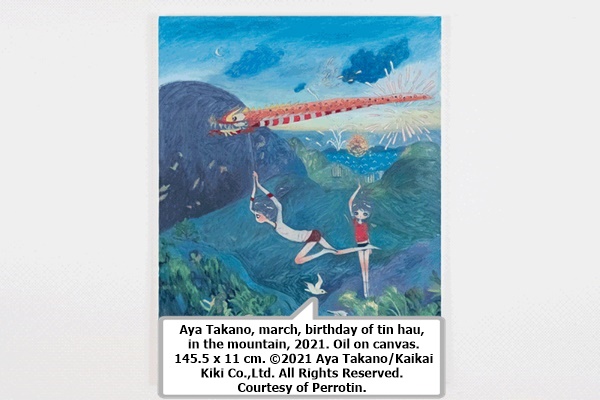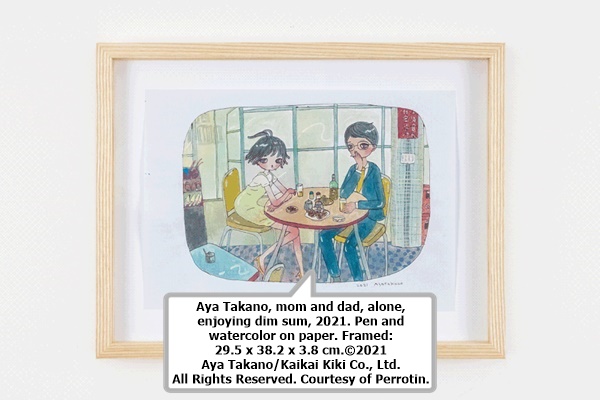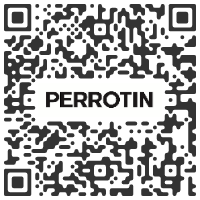"beginning, liminal, ego"
Aya Takano

PERROTIN
8/F, K11 ATELIER VICTORIA DOCKSIDE, 18 SALISBURY ROAD, TSIM SHA TSUI, HONG KONGT: +852 3758 2180 / F: +852 3758 2186 e-mail:
Multiple location : Shanghai New York Paris(3) Hong Kong Tokyo Seoul



June 26 > July 24, 2021


Perrotin Hong Kong is pleased to present a solo exhibition by
Japanese artist Aya Takano, marking the artist’s second presentation
at the Hong Kong space, since her debut in 2012. In these series of
ten paintings and twenty-four drawings, Aya Takano has created an
ode to Hong Kong like no other, capturing its landscapes, its culture
and its quirks, in a happy and colourful tribute that puts on display the
artist’s intimate affection for the city.
The defiantly ethereal characters that have come to represent her Superflat approach to painting and illustration come to life on her canvas and under her pencils, with their huge eyes and endless limbs. Here, though, they are not intent on a space mission or busy floating in a dreamy Tokyo/outerspace scenery (Takano is a renowned Science Fiction writer, like English readers can see in her Spaceship EE). They are right in Hong Kong, playing with kites and dragons; selecting the best gold fish from little plastic bags filled with water next to Prince Edward’s Flower Market; sitting nonchalantly in a chaa chaan teng; or all wrapped up in a plastic raincoat as the monsoon rains wash over the territory. In the paintings – mostly large compositions that detail both the actions performed by the characters and the precise backgrounds against which they move – we can see the mountainous profile of the city, with its lush greenery, countless birds, waterfalls and natural pools contrasted with the high-density buildings that dot the landscape, the sea in Victoria Harbour, and the ever changing subtropical sky, with fluffy clouds in white, grey and pink.
Against this perfectly recognizable backdrop, Takano positions her intriguing characters, as they move about engaged in games and occupations of their own, little concerned with what anyone is thinking. They stare out of their world in a direct way, and hold the viewer’s gaze fully and unapologetically. They move in front of our eyes in total control of their space, just like creatures from a parallel universe who have no compulsion to explain themselves. And yet, in this new Hong Kong incarnation, each of them reminds us of someone we may have seen in the street, a boy or a girl busy preparing a Lunar New Year lion dance in one of the rural districts of the territory, or again dressed in their fashion forward best, as they consume an iced drink, or someone sitting alongside the offerings for the Hungry Ghost Festival, as they slowly burn inside their metal bins.
In this colorful homage to Hong Kong, Takano has chosen to highlight some aspects of this high density urban/subtropical green rural environment selecting some details that are both immediately identifiable as from here, but skipping superficial and banal identifiers: she zooms in on the food of the territory, its transport system – the drawing in which three kids on the top deck of a tram are counting their coins to pay the ride’s fare, for example, is particularly touching for its abundance of detail and its lively palette – and its numerous festivals, a mixture of religious recurrences and celebratory occasions, mixing the everyday detail with the excitement of games and ritualized special occurrences.
Takano’s characters, even in this fresh incarnation as Hong Kong
people, are creatures from a dreamy universe: their hair and clothes –
never too much of those – flap in the breeze, and they seem to hang
in a liminal space that is neither entirely terrestrial nor completely
imaginary. Their flatness and tell-tale backgrounds puts them in a
straight line of descent from ukiyo-e’s prints that continue to influence
artists in Japan and abroad: woodblock images produced from the
seventeenth and nineteenth century depicting scenes from the
floating world – the literal translation of ukiyo-e, homophonous with a
Buddhist term to indicate impermanence of earthly experiences – or
pleasure quarters of Edo and Kyoto, representing famous actors,
courtesans, entertainers, and vignettes from farmers and fisherman’s
lives that would be witnessed by traveling artists and pilgrims intent
on visiting the famous scenic spots in the country. While Hokusai and
Utamaro have become household names all over the world, the
ukiyo-e tradition has influenced the progressive erasing of depth in
order to present images that re striking for their immediacy. Ukiyo-e is
present in the contemporary manga and anime aesthetic, and here
too, in Takano’s subtle take both on flatness, impermanence, and on
the centrality of characters, even when they are enigmatic creatures
that interrogate us as much as communicate with us. A thin, quick line
describes their contours, and the economy of facial expressions make
Takano’s chromatic choices one of the main conveyers of meaning,
feeling and nuance.
All Takano’s favorite obsessions are here, getting more accomplished and expressive with time: the fantastical perspective that subverts the landscape isn’t intended to give a realistic scale, but puts the dreamy, big-eyed creatures in the middle of an impermanent world. It is a universe populated mostly by girls, very comfortable with themselves and their own bodies as they listen to music, play with items of consumeristic entertainment, or smoke a cigarette with the same spontaneity with which they would put a pen into their mouth as while writing their school assignments, or play with old-fashioned Hong Kong toys – rather indifferent to the laws of gravity throughout. And as it is customary with her work, we are indeed in a floating world ourselves as we look at her creations, somewhere in between past, present and future, in a different dimension that we can access only through her eyes.
As Hong Kong has been rocked by years of hardship and the pandemic that has been affecting the whole world, the Superflat creatures that populate Takano’s paintings and drawings carry in their hands countless homages to local daily life that brings us back to more normal days. Her endearing attention to Hong Kong’s vernacular and its numerous cultural hybridities requires attention, as detail after detail she keeps surprising the viewer with yet another specific observation.
Born in Saitama, in the outskirts of the Tokyo area, in 1976, Aya Takano grew up immersed in the intense visual culture of post-war Japan made of manga, anime, science fiction, to which she added a persisting curiosity and interest for natural sciences and the juxtaposition between nature landscapes and urban landscapes – a duality that comes to perfect fruition in her observations of a place like Hong Kong. She then went on to receive a formal training as an artist at Tokyo’s Tama Art University, from where she graduated in 2000, and soon thereafter started to work together with Murakami Takashi, and became part of Kaikai Kiki Co. The years in which Takano developed her artistic sensitivities were the ones in which Japan had already established itself as an economic powerhouse, after the destruction of World War II, and in which consumer culture had started to add both a dreamlike and playful quality to daily life, but also a disquieting insistence on sexualizing young women and girls and turning them into the target of consumption. Takano subverts this commercial operation by turning her characters into irreverent participant in this dynamic: they float, they enjoy themselves, they love, eat, drink and play, and are very much their own masters, taking from a commercialized world only what suits them, and disregarding the attempt at turning them into objects.
The way in which Takano turns the table on the fetishization of young women and girls adds yet another layer to this Superflat universe, which, in spite of its insistence on just two dimensions, keeps showing new ways of looking at our world. In the Hong Kong series everything is delicately intertwined, bringing together the Japanese artistic tradition of vignettes of mundane moments with a photographic quality, with the Buddhist attention to the transient, illusionary quality of all earthly human experience, and a special appreciation for Hong Kong’s most enduring aesthetic, untouched by a time of strife and uncertainty.
The defiantly ethereal characters that have come to represent her Superflat approach to painting and illustration come to life on her canvas and under her pencils, with their huge eyes and endless limbs. Here, though, they are not intent on a space mission or busy floating in a dreamy Tokyo/outerspace scenery (Takano is a renowned Science Fiction writer, like English readers can see in her Spaceship EE). They are right in Hong Kong, playing with kites and dragons; selecting the best gold fish from little plastic bags filled with water next to Prince Edward’s Flower Market; sitting nonchalantly in a chaa chaan teng; or all wrapped up in a plastic raincoat as the monsoon rains wash over the territory. In the paintings – mostly large compositions that detail both the actions performed by the characters and the precise backgrounds against which they move – we can see the mountainous profile of the city, with its lush greenery, countless birds, waterfalls and natural pools contrasted with the high-density buildings that dot the landscape, the sea in Victoria Harbour, and the ever changing subtropical sky, with fluffy clouds in white, grey and pink.
Against this perfectly recognizable backdrop, Takano positions her intriguing characters, as they move about engaged in games and occupations of their own, little concerned with what anyone is thinking. They stare out of their world in a direct way, and hold the viewer’s gaze fully and unapologetically. They move in front of our eyes in total control of their space, just like creatures from a parallel universe who have no compulsion to explain themselves. And yet, in this new Hong Kong incarnation, each of them reminds us of someone we may have seen in the street, a boy or a girl busy preparing a Lunar New Year lion dance in one of the rural districts of the territory, or again dressed in their fashion forward best, as they consume an iced drink, or someone sitting alongside the offerings for the Hungry Ghost Festival, as they slowly burn inside their metal bins.
In this colorful homage to Hong Kong, Takano has chosen to highlight some aspects of this high density urban/subtropical green rural environment selecting some details that are both immediately identifiable as from here, but skipping superficial and banal identifiers: she zooms in on the food of the territory, its transport system – the drawing in which three kids on the top deck of a tram are counting their coins to pay the ride’s fare, for example, is particularly touching for its abundance of detail and its lively palette – and its numerous festivals, a mixture of religious recurrences and celebratory occasions, mixing the everyday detail with the excitement of games and ritualized special occurrences.
All Takano’s favorite obsessions are here, getting more accomplished and expressive with time: the fantastical perspective that subverts the landscape isn’t intended to give a realistic scale, but puts the dreamy, big-eyed creatures in the middle of an impermanent world. It is a universe populated mostly by girls, very comfortable with themselves and their own bodies as they listen to music, play with items of consumeristic entertainment, or smoke a cigarette with the same spontaneity with which they would put a pen into their mouth as while writing their school assignments, or play with old-fashioned Hong Kong toys – rather indifferent to the laws of gravity throughout. And as it is customary with her work, we are indeed in a floating world ourselves as we look at her creations, somewhere in between past, present and future, in a different dimension that we can access only through her eyes.
As Hong Kong has been rocked by years of hardship and the pandemic that has been affecting the whole world, the Superflat creatures that populate Takano’s paintings and drawings carry in their hands countless homages to local daily life that brings us back to more normal days. Her endearing attention to Hong Kong’s vernacular and its numerous cultural hybridities requires attention, as detail after detail she keeps surprising the viewer with yet another specific observation.
Born in Saitama, in the outskirts of the Tokyo area, in 1976, Aya Takano grew up immersed in the intense visual culture of post-war Japan made of manga, anime, science fiction, to which she added a persisting curiosity and interest for natural sciences and the juxtaposition between nature landscapes and urban landscapes – a duality that comes to perfect fruition in her observations of a place like Hong Kong. She then went on to receive a formal training as an artist at Tokyo’s Tama Art University, from where she graduated in 2000, and soon thereafter started to work together with Murakami Takashi, and became part of Kaikai Kiki Co. The years in which Takano developed her artistic sensitivities were the ones in which Japan had already established itself as an economic powerhouse, after the destruction of World War II, and in which consumer culture had started to add both a dreamlike and playful quality to daily life, but also a disquieting insistence on sexualizing young women and girls and turning them into the target of consumption. Takano subverts this commercial operation by turning her characters into irreverent participant in this dynamic: they float, they enjoy themselves, they love, eat, drink and play, and are very much their own masters, taking from a commercialized world only what suits them, and disregarding the attempt at turning them into objects.
The way in which Takano turns the table on the fetishization of young women and girls adds yet another layer to this Superflat universe, which, in spite of its insistence on just two dimensions, keeps showing new ways of looking at our world. In the Hong Kong series everything is delicately intertwined, bringing together the Japanese artistic tradition of vignettes of mundane moments with a photographic quality, with the Buddhist attention to the transient, illusionary quality of all earthly human experience, and a special appreciation for Hong Kong’s most enduring aesthetic, untouched by a time of strife and uncertainty.
 | Aya Takano | |
Opening :
Saturday June 26
mpefm
HONG KONG art press release
Gallery Hours:
Tuesday to Saturday, 11am – 7pm
Visitors are required to register at the concierge to enter the building.

Gallery Hours:
Tuesday to Saturday, 11am – 7pm
Visitors are required to register at the concierge to enter the building.
QR of this press release
in your phone, tablet








